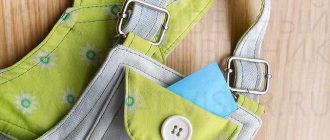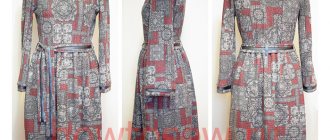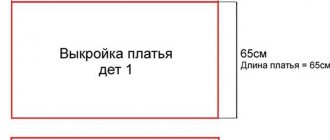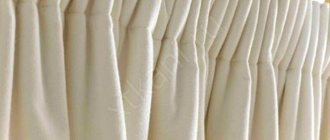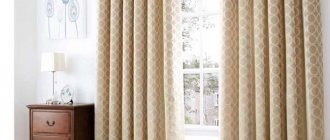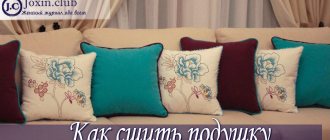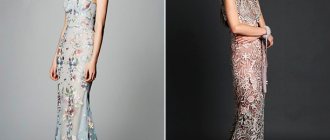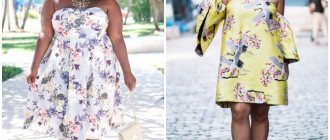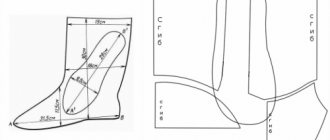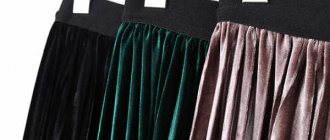Gabardine (French gabardine ) - cotton, wool or silk fabric of diagonal or twill weave; it is thin, very dense, elastic, soft and has good rollability. Due to the increased density of the warp threads, the weft threads are almost completely hidden, and wide, steep diagonal scars are formed on the surface of the fabric. Pure wool gabardines are made from twisted warp and weft yarn; half-woolen gabardines - made from twisted pure wool or mixed (with viscose or synthetic fiber) yarn in the warp and in the weft from twisted cotton or staple (or mixed) yarn. The fabric is usually plain-dyed. Gabardines are recommended for ladies' suits , coats , and raincoats .
The main feature of gabardine is its diagonal ribs. They are formed due to the peculiarities of the choice of threads: warp threads are thicker than weft threads. Twill weave allows you to create an original relief, making dense fabric softer, more manageable and attractive.
Initially, Gabardine is a woolen fabric made from merino yarn, very thin, double-twisted for the warp, and less thin, single-twisted for the weft. Thanks to the use of a special type of weave - complex twill, a sharply defined small scar is formed on the front surface, running obliquely at an angle of 60-70°. Spring-summer men's and women's coats , as well as suits and some types of officer uniforms are made from gabardine.
Gabardine was invented in 1879 by Thomas Burberry, founder of the famous Burberry brand, which is still famous today. Gabardine became famous because of its special weave, which creates an original rib. Nowadays, synthetic fibers or twisted viscose yarn are sometimes used to make gabardine.
Thanks to its unique texture, like polar fleece , gabardine can be used not only in clothing production, but also in other industries. They use it to upholster furniture , make pillows , sew curtains and use it in art workshops. Furniture covered with gabardine has increased wear resistance and does not lose its original appearance for a long time, and paintings painted on gabardine look brighter and more vibrant. As for clothing, this fabric is very widely used in the production of both casual clothing and uniforms and military uniforms. Due to the fact that gabardine clothing
Pure wool, half-woolen, silk, staple and cotton gabardine are produced.
Modern gabardines are made from special water-repellent impregnation, “boiled”, etc.
History of fabric
In the second half of the nineteenth century, heavy but waterproof mackintosh raincoats were popular as clothing to protect against wet and rainy weather, which was by no means uncommon in London. The material from which they were made was impregnated with rubber, and therefore had a significant drawback - it did not allow air to pass through.
Everything changed after, in 1880, the manufacturer Thomas Burberry invented a waterproof fabric that could “breathe” - gabardine.
The material got its name from the loose clothing - “gabardine”, in which beggars and travelers in the Middle Ages sheltered from bad weather.
Thus, Thomas came up with such a tight weave of thread that drops that fell on the surface of the fabric were not absorbed, but flowed off it. He borrowed the name of the fabric from the Middle Ages, at that time the word “gabardine” was used to describe royal capes and robes.
Later, in 1888, Burberry patented the technology for making this material. For a long time, Burberry and his manufactory specialized in clothing for the military and travelers. It was an order for the British troops that prompted Thomas to sew some types of officer uniforms from this material.
After this, a group of polar explorers led by Roald Admundsen in 1911 gathers on an expedition to conquer the Southern Polis. Most of their uniforms were made of gabardine. And the polar team becomes the first people to conquer this part of the world, which added to gabardine’s fame.
During World War I, Thomas Burberry made army outerwear from this fabric. And in the 40s, raincoats became popular largely due to their waterproofness. In them, unlike rubberized raincoats, the body “breathed”, and they looked much more noble.
Initially, gabardine was made exclusively from wool, but over time, cotton or polyester . And the more polyester, the more shine the fabric gets. The fair half of humanity took advantage of this quality, and in the 40s, gabardine trousers skirts , and suits became increasingly popular.
As the description of historians testifies, wool from Merino sheep was used for the fabric produced by Burberry . On one side, the material was smooth, and on the other, with a relief pattern of thin stripes. The first types of matter were painted black , white and sand. Such properties of the material as resistance to the formation of wrinkles and folds appealed not only to army personnel, but also to the civilian population. And now not only outerwear , but also trousers , skirts and casual suits made of gabardine have become firmly established in the everyday life of British fashionistas.
The first gabardines had the natural color of sheep's wool. They were white, black or beige. Later the material began to be painted in other colors.
Sewing yourself a coat from gabardine was considered chic. In fact, it is thanks to this material that the Burberry brand has become so popular.
Over the years, the composition of the fabric has changed. to wool , and the material was called wool blend. Subsequently, cotton and silk fabrics with diagonal relief appeared, and the word “gabardine” lost its original meaning. Today it does not characterize the composition, but only the special, so-called “twill” weaving of threads.
Gabardines, obtained from natural raw materials, are distinguished by their noble matte finish. The addition of synthetic fibers leads to the appearance of shine in the material, and the higher the percentage of synthetics in the fabric, the brighter it shines.
Composition and properties
The original composition of the material invented by Burberry is pure sheep wool .
Over time, gabardine began to be made not only from wool, but also other fibers were added to it. The composition sometimes includes cotton or synthetics, which undoubtedly diversifies the use of the fabric.
Currently, the composition of gabardine is wool, wool blend, synthetic, silk and cotton. .
It should be noted that material made from natural raw materials is matte, and synthetics add shine to it, and the more artificial fibers it contains, the stronger this shine.
The characteristics of the fabric will vary depending on the type of fibers in its composition, but there are still general properties:
- The material drapes softly and beautifully, especially when cut on the bias.
- Despite its high density, the fabric is quite light and soft.
- Keeps its shape well and does not deform when washed.
- Good air permeability.
- Resistant to wear.
- Good performance characteristics: easy to iron, removes stains well.
- Resistant to getting wet. The threads in the fabric are twisted so tightly that they repel water.
The material, which contains 100% polyester , is quite cheap in cost, so it is loved by people who are just beginning to learn the basics of sewing.
Surface density of fabrics is 290-440 g/m2. Gabardines are hard, free-flowing, can be cut with a needle, and are difficult to mold during wet-heat treatment.
The back side of the fabric is smooth, and the front side has a relief striped pattern.
Wool gabardine , or any tightly woven worsted wool , is a two-dimensional, smooth, wrinkle-free material that is cool to the touch. The very nature of this fabric makes it very attractive and flowy. But it is precisely this property that can spoil the appearance of the product when sewing and ironing. In European workshops for tailoring men's clothing to order, there are always one or two craftsmen who specialize in working with gabardine.
For gabardine, you should carefully select the style and finish. For the first experience, it is recommended to choose a raglan sleeve or a dropped armhole, a stand-up collar or a neckline with facings, as well as a loose fit. Gabardine pieces are difficult to set in accurately, so avoid set-in sleeves and scalloped collars unless you are an experienced dressmaker. Light-colored fabrics are easier to iron than dark ones.
At first, gabardine was produced in black, gray, blue, white and sand colors. Now the variety of colors is huge! Gabardine color , mostly plain, without a pattern.
Logos can be successfully printed on cotton and synthetic fabrics.
Pros and cons of Gabardine
The strong weave explains the remarkable properties of the material.
- Exceptional durability. A gabardine product may go out of style over time, but it will retain its original, fresh appearance for many years to come.
- Drapes beautifully. This property is especially good with a complex cut, enlivening the laconicism of a smoothly colored material. Synthetic fabrics, cut on the bias, flow beautifully and emphasize the figure.
- Reliably keeps its shape. Gabardines do not deform when washed and practically do not stretch.
- Resistance of the material to jamming and mechanical stress. It is particularly wear resistant.
- Breathability. The products do not create a greenhouse effect. These breathable fabrics do not emit textile dust and are comfortable to wear.
- Low moisture permeability is explained by tightly twisted threads that repel water droplets.
- Easy to care for. Gabardine products are easy to keep clean and tidy: they remove stains well and are easy to iron.
Negative qualities include high flowability. The material may be damaged by the sewing needle.
Attractive qualities
Even with different compositions, gabardine has the same properties thanks to the thread weaving technology used.
- Softness and lightness despite the fact that the fabric is considered dense.
- Sufficient breathability.
- It wrinkles little and quickly regains its shape thanks to its elasticity.
- Increased moisture resistance, in which drops of water flow off and are not absorbed by the fibers. After treatment with impregnations, gabardine reliably protects from rain.
- Drapes easily and fits well.
- Resistance to mechanical damage.
- Easy to wash, iron and does not shrink when washed.
- It is wear-resistant and durable.
Where is it used?
- Excellent outerwear for men and women is made from thick woolen and wool blend fabrics: jackets , coats, suits . The water-repellent qualities of the material are enhanced by modern impregnations.
- Synthetic gabardine, easy to care for and relatively cheap material, is used to make school uniforms, corporate and workwear. Beautiful evening dresses .
- The material is excellent in home interiors. It is used to upholster upholstered furniture , to make tablecloths, curtains, and pillowcases for sofa cushions .
- The excellent contact properties of the canvas explain its use in advertising. Banners and advertising banners are made from white gabardine with logos clearly printed on it.
- It has been used for decades to make officer uniforms.
Types of gabardine
- Woolen. Great for sewing demi-season and light coats and suits. The diagonal scar on woolen products is clearly visible.
- Made from polyester. Often smoothly colored, the scar is visible only upon detailed close inspection. The properties of polyester are discussed in detail here. The material is cheap, so it is often used for sewing workwear. Skirts and trousers are also often made from it. It is recommended for beginner seamstresses as it is easy to work with.
- Mixed (contains natural and synthetic raw materials).
Gabardine can be quite thick and, conversely, thin fabric: it depends on the thickness of the threads.
Consumer Reviews
Many lovers of comfortable clothing call gabardine an all-season fabric. Not only is it stylish and durable, it is also relevant. Many people like this material for sewing workwear, because it hardly wrinkles.
The price for this or that type of gabardine is different: natural fabric is more expensive, synthetic fabric is cheaper. Many novice seamstresses prefer gabardine; it is easy to process and has an affordable price. The most affordable material is Chinese-made. The quality and price of the product captivates many.
Some artists use gabardine as a canvas for paintings. Many needlewomen combine it with other materials and decorate it with various frills and frills.
Production
Gabardine is usually called a group of fabrics that are distinguished not by composition, but by the method of weaving. The threads for this fabric are woven diagonally at an angle of 45 to 63 degrees, this gives the fabric a pattern in the form of a small diagonal strip. The warp threads are thinner than the weft and are twisted in half. And the weft threads are single. This distribution of threads makes the gabardine pattern in relief.
Originally, gabardine was a natural shade of sheep's wool. But modern technologies make it possible to paint it in a variety of colors. Among synthetic fabrics, gabardine melange has recently become fashionable.
Colors
To produce gabardine fabric, initially only sheep wool was used, so the color of the finished material was gray and similar tones. It was slightly different. In the 19th and early 20th centuries, fabric of several color groups was used to sew clothes:
With the advent of dyes, thanks to the addition of other threads to the composition, the color range of gabardine expanded. The palette is so diverse that you can choose any color. But the greatest demand is for suit fabric in calm tones.
How to determine that it is gabardine
The main distinctive feature of gabardine is the diagonal pattern - rib. It can be either very noticeable and prominent in wool and other dense varieties of material, or practically not noticeable if the material is woven from thin synthetic fibers.
So, how can we determine whether we are looking at gabardine or not? To do this, take the fabric in your hands and carefully examine:
- Firstly, a characteristic diagonal pattern - a rib, which is located on its front side - will help you recognize gabardine. The width of the scar may vary, but it will definitely be present. If we turn the fabric over to the wrong side, we won’t see any scars there - the wrong side of gabardine is absolutely smooth. Gabardine rib is formed due to the fact that during manufacturing the weft and warp threads are woven at an angle of 45 to 63 degrees, and the warp threads are twice as thin as the weft threads.
- Secondly, gabardine has a dense structure. Along with this, gabardine is a fairly soft fabric that has the ability to form beautiful folds. Depending on whether gabardine contains artificial fibers, it can be matte or shiny. Gabardine containing a large percentage of synthetic fibers will shine more than one that contains virtually none. And gabardine, made entirely from natural raw materials, will be matte.
At the very beginning, the production of gabardine was carried out only from natural sheep wool and its colors were not varied. Today you can find gabardine in all the colors of the rainbow, including melange colors.
Flaws
But twill textiles also have small shortcomings that can be easily dealt with if you know about them in advance. Discontent is caused by:
- Fear of high temperatures. That is why ironing with a hot iron is contraindicated for gabardine. It is also not recommended to boil gabardine products; this will negatively affect the appearance and structure of the fabric.
- Strong flowability when cutting. The edges of the cuts crumble, they need to be processed in a timely manner. This drawback makes it impossible to sew dresses with a complex cut from waterproof fabric: with set-in sleeves, figured collars.
- Delicacy of the canvas. A sewing needle can easily damage it. Therefore, experience is required to work with the material.
Application and care
What are they sewing?
Thick wool or wool blend gabardine is used for sewing outerwear: jackets, coats, suits. You can sew trousers , skirts , dresses , and tunics from thin varieties of material. Gabardine melange looks especially strict and at the same time elegant in women's dresses . Its colors, slightly muted and laconic, can be “revitalized” with an interesting cut: sew a dress with frills or a frill.
Suits are made from this material for medical workers, production employees or maintenance personnel.
Thanks to a wide range of colors and compositions, gabardine is an almost universal material. It can be used to sew men's and women's trousers , skirts , outerwear and tunics. Due to its strength, ease of care and durability, the gabardine composition of gabardine fabric has found wide use as a material for various workwear and uniforms. Gabardine is also used as a finishing fabric for upholstering furniture, sewing curtains and decorative pillows, etc.
This fabric is universal in its application. From gabardine you can sew not only clothes, but also interior decor items: tablecloths, curtains, napkins, pillowcases , etc.
It is used for upholstery. And on synthetic fabrics they print logos or designs for advertising products: banners, flags, advertising banners. White fabric is used as the basis for such products.
The most versatile fabric is gabardine made from artificial fibers. It is wear-resistant, wrinkle-resistant, holds its shape well, and practically does not shrink. These useful properties allow it to be used in sewing inexpensive, comfortable clothes - this can be a school uniform, corporate clothing , uniforms for waiters, and hotel staff. For this purpose, gabardine is often purchased in bulk.
Depending on the quality, gabardine fabric is widely used in the interior. These are tablecloths, bedspreads, napkins. Its price is very attractive - gabardine fabric is inexpensive and of high quality.
Gabardine stretch is an elastic variety of this fabric. Thanks to the addition of elastane, it stretches in one or both directions, which allows you to sew more complex and beautiful models of jackets, skirts, and trousers from it.
Caring for fabric and products made from it
As mentioned above, both wool , cotton and polyester . Naturally, this affects the way the product is washed and dried.
Caring for a gabardine product will depend on its composition. It is better to dry-clean pure wool varieties from which outerwear is made in order to maintain the shape of the product and avoid shrinkage. Polyester fabrics can be machine washed on a synthetic cycle at 40°C.
In general, it is best to follow the instructions on the product label.
In general, the fabric is easy to care for: washing, ironing, and removing stains will not be difficult.
When washed, gabardine usually does not deform and does not change color, unless the mode and temperature are chosen correctly.
Iron gabardine with a warm iron, but not too hot, as this can damage or deform the fabric. The exact temperature and mode are again determined by the composition of the fabric. Be sure to iron the product from the inside out and through gauze . This way you will maintain the matte texture of the material.
Caring for any product begins with carefully studying the labels with the manufacturer’s recommendations.
- As a rule, it is recommended to dry clean pure wool items.
- Wool blends are washed in a machine, if it has a function for hand washing wool (without tumble drying), or by hand in warm water.
- Polyester fabrics are washed in a gentle cycle at a temperature of 40 o C.
- The products are dried flat. Iron from the inside out with a low-heat iron through loose fabric or gauze. This keeps the material matte.
- Gabardine can be safely called an all-season fabric. Durable and stylish products always look trendy. They emphasize respectability and dignity at any time of the year.
Features of choice
When choosing gabardine you should consider:
- Product cut. The more complex it is, the more material will be required, since its loss during cutting increases. For example, expensive wool gabardine is suitable for a raincoat or jacket, and stretch or synthetic is suitable for a backpack or a complex dress.
- Fabric structure. For medical uniforms, casual dresses or shirts, cotton or wool gabardine would be appropriate, which will increase wearing comfort. For a cape or weekend suit, wool blend will be optimal, and for a demi-season raincoat, staple gabardine.
- Application of the product. The required stability of gabardine depends on the intensity of wear. For example, for a festive suit, woolen or half-woolen material would be appropriate, and for a dress or tailored suit, stretch material would be appropriate.
Note! Cost is an important indicator of the quality of gabardine. The less the fabric costs, the worse its quality.
Ironing gabardine
White vinegar helps to “seat” the press tightly and prevents the formation of shine. Dissolve 3-4 tablespoons of white vinegar in a cup of water. Test on a piece of fabric how it reacts to the mixture, and then use a sponge to apply it directly to the fabric. Apply it to the seam allowances while ironing. There will be no smell left.
Try ironing a piece of fabric first to determine the desired heat setting for your iron. Check for any scorching or shine. Can fabric be ironed on the front side? Through what fabric? What ironing press pressure should you set? Do you need vinegar?
Press each seam and dart in the desired direction to tighten the stitches and distribute thread tension evenly across the seam. While the fabric is still warm, use your finger to open the seams and, pressing, hold the press until the fabric has cooled. When ironing, do not move the iron over the fabric, but place it on the fabric so that there are no marks left on it.”
Sometimes it is necessary to iron the fabric again to achieve the desired result. You can remove shine with a clothes brush or wool rag dipped in white vinegar. But be careful: an iron that is too hot can leave permanent marks on the fabric. Craftsmen call such fabric “dead” and “ruined”.
To prevent the seams from imprinting on the front side, try to iron the seams on the tip of the block or on a special roller. You can erase seam marks on the front side by ironing under the seam on the back side with the tip of the iron. To finish, place strips of construction paper under the seams, iron, then press.
When working with particularly difficult fabrics, iron only the seam allowances using the additional attachment on the multi-function ironing board. Topstitching and finishing the seam with an overlocker helps maintain the shape of the part.
Use of a press, tailor's din and brush
When ironing, use a brush every time: when smoothing darts, ironing seam allowances and ironing the edges of the product. Apply pressure to a small area of the item, holding or leaving the brush on that area until the fabric cools.
Pull curved seams and darts over the gams using a brush. The ironing press is well suited for ironing straight seams. Also use the block to press seam allowances on straight seams or curved, narrow hems.
Of course, at present, many modern materials are superior to gabardine in water resistance, but despite this, gabardine trousers skirts , and suits remain popular among women and men of all ages.
Characteristics
Despite the fact that the material is quite dense, it is soft and lightweight. Clothes made from it are comfortable and save in cold or rainy weather. The fabric does not get wet, but at the same time it allows air to pass through perfectly, which protects against the greenhouse effect.
Due to its tendency to drape beautifully, linen is used to make not only outfits, but also theater decorations and home textiles. Different types of fabric are used for different products, which differ in composition. However, their properties remain similar, because the production method is the same.
Modern gabardine's performance is much higher than its original counterpart, invented in the 19th century. Technologies are constantly improving, and with them the quality of matter is improving.
